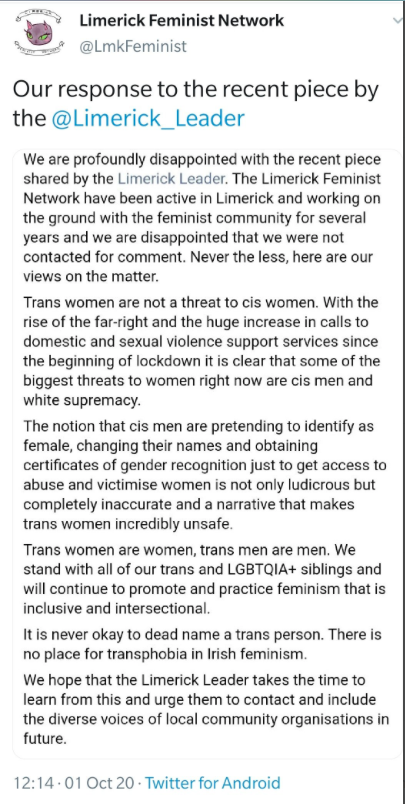This week Timothy Brehmer was acquitted of the murder of Claire Parry. Brehmer, a former police officer, had not denied that his actions had killed her. Instead, he said that he had not intended to kill her. That he had intended only to shove her out of the car, and yet somehow, she had ended up dead.
Women across the UK followed the case as Brehmer’s story changed. She had been breathing when he left the car, he said. He said she had tried to stab him. Or maybe not, maybe he had tried to stab himself. Her death must have been positional asphyxiation. Whatever, he hadn’t intended to kill or seriously harm her. Media reporting revealed descriptions of controlling coercive behaviour, and few had sympathy for the pity parade that constituted his reported evidence.
The verdict, acquitting him of murder, was met with outrage from feminists. How could we reach a stage where a man strangles a woman for at least 10-30 seconds with enough force to break three bones in her neck, his evidence is a kaleidoscope of unlikelihood, and yet somehow he is not guilty of her murder?
The answer lies in the “loss of control” defence. Importantly, we will never know why it is that the jury came to the verdict which they did. They had two options to reach their conclusion. One was that Brehmer’s evidence was true – or at least, they had some doubt that it was lies – and that he hadn’t really intended to seriously hurt or kill her when he strangled her. The second was that he had intended to seriously hurt or kill her, but that his actions arose from a “loss of control.”
Although we will not find out which of the two were the basis for the jury’s decision, we do know that the judge sentenced on the basis of loss of control. Once the verdict is in, it is for the judge to decide which is more likely, and to sentence on that basis.
The Bournemouth Echo, reporting the sentencing hearing, records that the judge said
“This is a case where I should sentence you [on the basis] that you lost your self control following the message that was sent to your wife, rather than you unintentionally killing Mrs Parry.
“I am sure that you did deliberately take Mrs Parry by the neck.”
He went on to make findings that the “loss of control” trigger was “only just met” and that Brehmer’s actions bore high culpability within the sentencing guidelines.
So what is “loss of control,” and how does it fit within the legal framework?
Before 2010, the defence was one of “provocation.” It was up to the jury to decide whether a person had been provoked sufficiently to lose their control and thereby to benefit from the reduced sentence for manslaughter, not being guilty of murder. It produced some absolutely shocking results: Thomas Corlett, who got three years for killing his wife after she ‘provoked’ him by moving the mustard pot to the wrong side of the table, for example. It was referred to by campaign stalwarts Justice for Women as the “nagging and shagging” defence, because it enabled men to argue that their wife being unfaithful or arguing had reasonably provoked them to kill her. After some significant campaigning, law reform was finally proposed in 2008, slowly made its way into the Coroners and Justice Act 2009, which was enacted in 2010. The relevant provision is this:
What is this “qualifying trigger?” Nagging and shagging is explicitly excluded, or so the drafters hoped:
In plainer terms, the questions are these: under s.54, was there a loss of control? Was there a qualifying trigger? And might any other comparator in similar circumstances have behaved the same way? If so, s.55 tells us what the qualifying triggers are – here, did the victim say something or do something ‘extremely grave’ and causing the defendant to have a ‘justifiable sense of being seriously wronged?’
“The fact that a thing done or said constituted sexual infidelity is to be disregarded” was intended to ensure that men who felt ‘provoked’ by their partner’s cheating (or alleged cheating) did not get away with murder.
We should recall, a decade later, that there was considerable opposition to this from some quarters. Feminists were accused of “feminising the law.” Dominic Grieve objected that “the Government have decided that thousands of years of human history and experience should be jettisoned for a piece of political correctness and proclamation: a declaratory statement that sexual infidelity can never justify violent behaviour.” Others pointed out that since men do kill in violent rage, it would be improper to prevent a jury from considering infidelity.
There were also objections that the clause was poorly drafted. These, unfortunately, were rather better founded. What constitutes ‘sexual infidelity,’ how grave is extremely grave and how serious is a serious wrong? Most importantly, what happens if sexual infidelity is just part of a wider context of loss of control? These were the questions considered in R v Clinton, a case concerning three men, who in the span of three weeks had each killed their partner. The Lord Chief Justice, giving judgment, said that “The starting point is that it has been recognised for centuries that sexual infidelity may produce a loss of control in men, and, more recently in women as well as men who are confronted with sexual infidelity.”
The Court went on to take the view that while the new law meant that infidelity alone could not constitute a qualifying trigger, infidelity could still be considered if there was a wider context: “In our judgment, where sexual infidelity is integral to and forms an essential part of the context in which to make a just evaluation whether a qualifying trigger properly falls within the ambit of subsections 55(3) and (4), the prohibition in section 55(6)(c) does not operate to exclude it.”
In Brehmer’s case, the trigger was not sexual infidelity, but the fear of her revealing the affair they were having, and so there was no prohibition on this being considered a ‘qualifying trigger.’
One question raised by all of this is where coercive control, not considered in 2008, would fit in. How should the law approach men who kill not because they lose control of themselves, but because they are losing control of their partner? Can or should statute try to draw the distinction?
It leads us to a situation where the solution is, perhaps, not available in law. The 2009 changes sought to block one such avenue, but were rather defeated in Clinton. What the defence of “loss of control” really needs is social change whereby the question as to whether a man in the same circumstances, with a “normal degree of tolerance and self-restraint” might act the same way, is met with a jury which says “absolutely not.”





